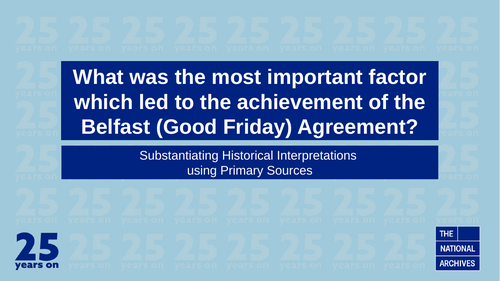


Historians substantiate their interpretations of the past by supporting their claims with evidence from primary sources. This is why two of the key assessment objectives at A Level are:
Understanding and evaluating historical interpretations.
Using and assessing a range of historical sources
Part 1: What role did the key figures in the peace process play? Is it possible to argue that there was one key figure or group?
This task provides A Level students with a collection of sources which will allow them to evaluate the role of key players and perhaps reach a judgement on how the work of these key players came together.
Study each interpretation and summarise the key points made by the historian.
- What do they argue is the most important factor, individual or group?
- How did this contribute to the peace process and Belfast (Good Friday) Agreement?
- What challenges and obstacles had to be overcome?
- What evidence is given to support this interpretation?
- Does the historian’s biographical information help to explain their interpretation?
- From your own knowledge how convincing do you find this interpretation?
- What further evidence would you want to find in the documents to make the interpretation convincing?
- If you were to provide a one-word summary of this individual’s contribution, which of these would you choose, or can you think of a better word? Obstructive / Unhelpful / Marginal / Constructive / Helpful / Pragmatic / Visionary / Essential
Part 2: Testing the views against the documents
This resource is NOT an exam practice paper. It is designed to explore how historians think about documents and make use of them. Students are introduced to the concept of a line of argument and to testing this against evidence from a range of documents. This will enable them to respond more effectively to the source and interpretation papers in their examinations.
All of the documents come from either:
- The National Archives of the United Kingdom
- The National Archives of Ireland
- The Public Record Office of Northern Ireland
For each document a number of discussion questions are posed which are designed to engage students in focused reading of the text. Students are then asked to consider whether the document could be used as evidence to support a particular view.
Carefully study the pack of 10 documents about the peace process.
- Decide whether each document could be used as evidence to support Views 1, 2, 3, 4 or 5.
- Remember that documents may support more than one view
- Decide whether they constitute strong, convincing evidence or whether more evidence is required to substantiate the interpretation and support the historian’s line of argument.
Please note, the transcripts of the resources retain any typographical errors included in the original documents.
Something went wrong, please try again later.
This resource hasn't been reviewed yet
To ensure quality for our reviews, only customers who have downloaded this resource can review it
Report this resourceto let us know if it violates our terms and conditions.
Our customer service team will review your report and will be in touch.